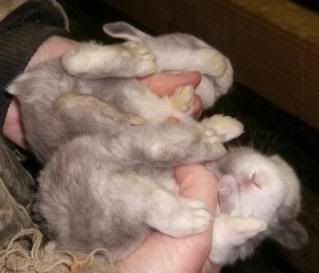I'm assuming it's some odd genetic thing.
But what would cause two rabbits to create babies that have small or no tails? It's a mixed litter of normal tailed, small tailed and no tailed kits.
Both rabbits have previous litters with other rabbits without the tails being an issue.
Are these rabbits one should breed from if one is wanting to further the breed? Or should they be avoided with a ten-foot pole? I'm supposed to get one back from the breeding, but I'm wondering how I should treat any offspring from that doe (should one prove to be female). Should I consider them all to be pet stock or terminal ends? OR can I use them as I would any breeding pedigreed rabbit?
It's not like it's a horrid thing like a split penis or something...just odd tails.
Told the gal who has them that she has a new breed...the Manx rabbit! She's not concerned as they are for meat, but I"m just curious about it as I'm supposed to get one back.
She's not concerned as they are for meat, but I"m just curious about it as I'm supposed to get one back.
But what would cause two rabbits to create babies that have small or no tails? It's a mixed litter of normal tailed, small tailed and no tailed kits.
Both rabbits have previous litters with other rabbits without the tails being an issue.
Are these rabbits one should breed from if one is wanting to further the breed? Or should they be avoided with a ten-foot pole? I'm supposed to get one back from the breeding, but I'm wondering how I should treat any offspring from that doe (should one prove to be female). Should I consider them all to be pet stock or terminal ends? OR can I use them as I would any breeding pedigreed rabbit?
It's not like it's a horrid thing like a split penis or something...just odd tails.
Told the gal who has them that she has a new breed...the Manx rabbit!




